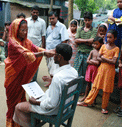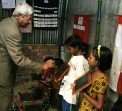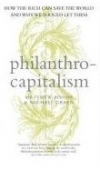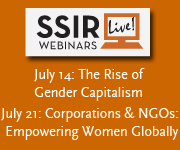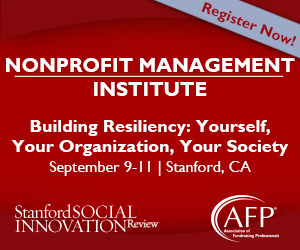ISSUE
Articles on social change from the latest edition of SSIR

Winter 2009
Volume 7, Number 1
In the winter 2009 issue of Stanford Social Innovation Review, “The New Volunteer Workforce” highlights just how poor a job most nonprofits do of utilizing volunteers—to the tune of $38 billion a year in lost labor. This is an area worth focusing on, as retiring baby boomers begin to turn their attention to volunteer opportunities. And, in “Romanticizing the Poor,” Aneel Karnani tackles the fundamental flaws in viewing those at the “bottom of the pyramid” as fledgling entrepreneurs who only need a small boost in order to turn their lives around.
Features
Calculated Impact
By estimating the social return on their investments, funders can deploy their dollars more effectively. To demonstrate the power of these calculations, the authors show how three organizations—the Robin Hood Foundation, Acumen Fund, and the William and Flora Hewlett Foundation—use cost-benefit analysis to evaluate their ongoing programs, choose mission investments, and plan long-term strategies.
Romanticizing the Poor
Market solutions to poverty, which include services and products targeting consumers at the “bottom of the pyramid,” portray poor people as creative entrepreneurs and discerning consumers. Yet this rosy view of poverty-stricken people is not only wrong, but also harmful.
The New Volunteer Workforce
Nonprofits rely heavily on volunteers, but most CEOs do a poor job of managing them. As a result, more than one-third of those who volunteer one year do not donate their time the next year—at any nonprofit. That adds up to an estimated $38 billion in lost labor. To remedy this situation, nonprofit leaders must develop a more strategic approach to managing this overlooked and undervalued talent pool. The good news is that new waves of retiring baby boomers and energetic young people are ready to fill the gap.
Lobbying for Good
In their efforts to be socially responsible, most companies fail to wield their most powerful tool: lobbying. Yet corporations such as Mary Kay, Royal Dutch Shell, and General Motors are increasingly leveraging their deep pockets, government contacts, and persuasive powers for the cause of good. Not all kinds of socially responsible lobbying are created equal, however. The authors discuss which forms are best for companies and society.
What's Next
Let’s Share
A new evaluation tool allows donors and investors to track their investments and compare their data to those of organizations doing similar work.
Beyond Microfinance
Two new players in the world's social investing scene seek financial returns along with social impact.
Field Report
Nau and Again
When Nau, an outdoor clothing start-up from Portland, Ore., launched in 2005, word on the street had it that the company would push socially responsible business to new heights. But barely a year after putting its earth-toned parkas and virgin merino wool sweaters up for sale in its übercool “webfront” stores, Nau pulled the plug. Find out how Nau tried on too much, too fast.
Eyeing Talent
VisionSpring picks promising social entrepreneurs to restore the eyesight of poor people.
Clicking for Smart CSR
National Instrument's partnerships not only energize science education, but also boost the company's brand and employee morale.
Left: An engineer readies her robot at the 2008 FIRST Lego League World Festival, an annual competition that brings together teams of students to show off their engineering chops. Powering her robot was sophisticated software developed by National Instruments. Her team, the Power Peeps of Swartz Creek, Mich., placed third.
Case Study
In the Black with BRAC
Serving more than 110 million people per year, BRAC is the largest nonprofit in the world. Yet it doesn't receive the most charitable donations. Instead, BRAC's social enterprises generate 80 percent of the organization's annual budget. These revenues have allowed the organization to develop, test, and replicate some of the world's most innovative antipoverty programs.
Viewpoint
Full Scale Ahead
To grow to full scale, serving 50,000 students a year, YouthBuild's federal funding must increase from $60 million to $125 million annually. Local programs will also need to raise $250 million annually from state and local education and criminal justice funds, and from private donors. How does YouthBuild plan to achieve this breakthrough and help five times as many people?
Research
The End of the World Is Nigh (Maybe)
Research finds human extinction looms near if consumption levels do not decrease.
Emotional Brands Bring the Bucks
Research shows branding differentiates nonprofits in stakeholders' minds.
Books
Great Minds Think Different
Iconoclast: A Neuroscientist Reveals How to Think Differently by Gregory Berns
The New Noblesse Oblige
Philanthrocapitalism: How the Rich Can Save the World by Matthew Bishop & Michael Green
Q&A
Q&A: William Brindley
William Brindley spent most of his career keeping financial institutions at the leading edge of technology. Now, as CEO of the nonprofit consortium NetHope, he is using those same skills to help nonprofits do the same. NetHope now has 25 member organizations, among them Save the Children, Mercy Corps, Oxfam, the International Federation of Red Cross and Red Crescent Societies, and Catholic Relief Services.
 → This form is for US/Canada subscribers. Are you an international subscriber?
→ This form is for US/Canada subscribers. Are you an international subscriber?
Click here instead.
Subscribe Now!
Subscribers get premium online access (articles with a key) including 9-year archive, downloadable digital edition, quarterly print issues (optional).






